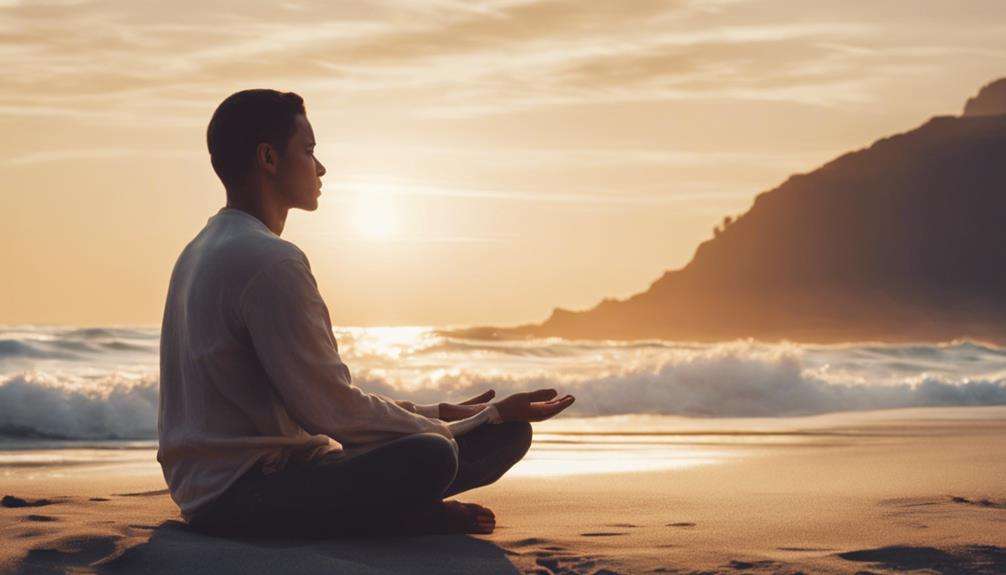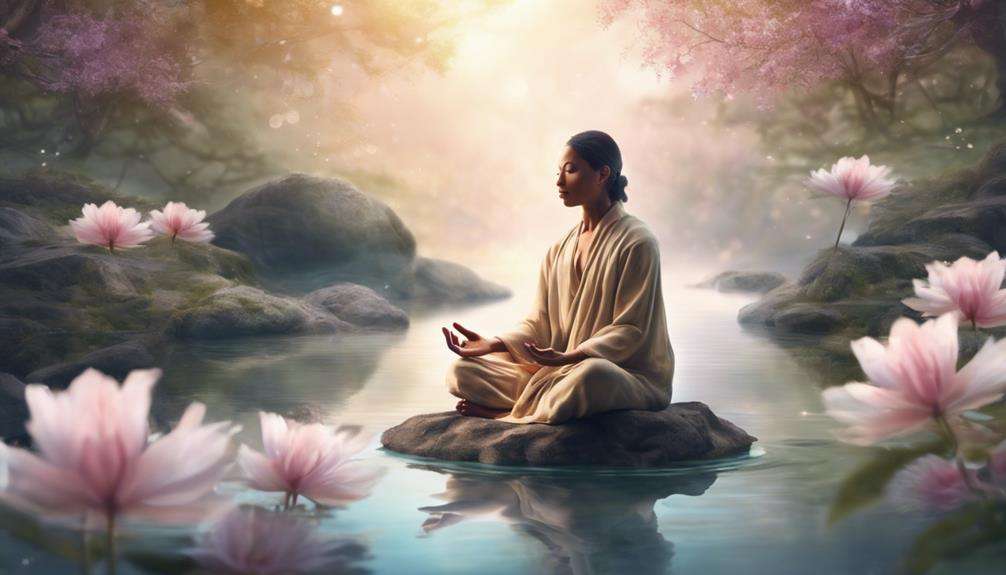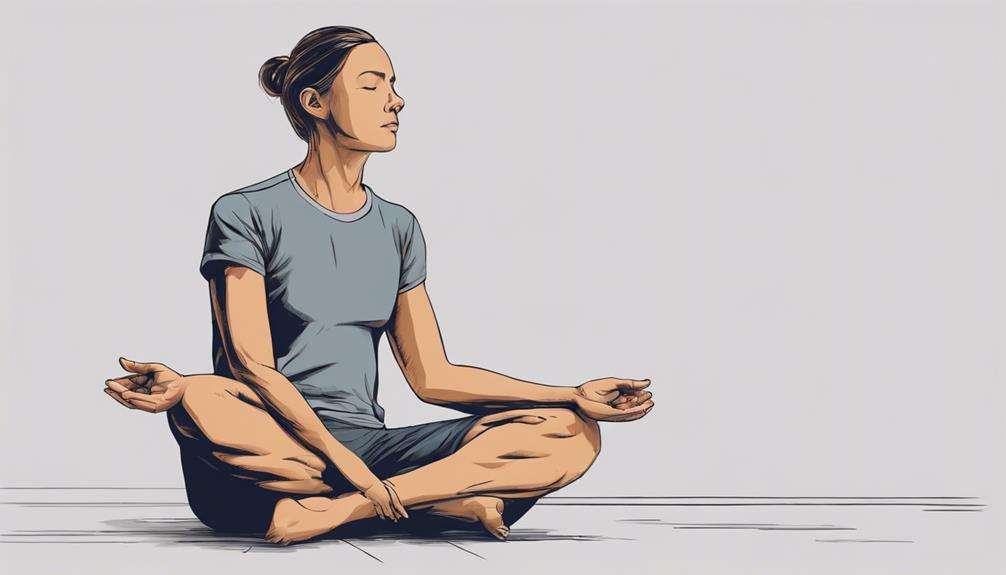Did you know that according to a recent study, over 200 million people worldwide practice meditation for various well-being benefits?
Discover how incorporating meditation into your daily routine can not only reduce stress and anxiety but also improve your overall mental and physical health.
By exploring the ultimate guide to meditation, you'll uncover a wealth of techniques and insights that can help you achieve a state of calmness and balance.
Find out how meditation can positively impact your life in ways you never imagined.
Key Takeaways
- Meditation reduces stress and boosts overall well-being, promoting peace and tranquility.
- Techniques like breath focus and visualization deepen relaxation, enhancing the meditation experience.
- Mind-body connection in meditation fosters relaxation, reducing stress and promoting balance.
- Relaxation meditation improves sleep quality by soothing the mind and body for restful sleep.
Benefits of Enhanced Relaxation Through Meditation
By practicing meditation for enhanced relaxation, you can experience a profound reduction in stress levels and a significant boost to your overall well-being. Meditation serves as a powerful tool to explore the mind and body, allowing you to let go of the tension and worries that accumulate throughout the day. As you explore into your practice, you may notice a gradual decrease in your stress levels, leading to a greater sense of peace and tranquility.
Through the act of meditation, you give yourself the gift of relaxation, creating a space for your mind to unwind and rejuvenate. This dedicated time to focus inwardly can have a ripple effect on your entire being, promoting a sense of balance and harmony. As you make meditation a regular part of your routine, you cultivate a state of calm that can permeate through various aspects of your life, helping you navigate challenges with a clearer and more grounded perspective.
Incorporating meditation into your daily life can be a transformative experience, offering you a sanctuary of stillness amidst the chaos of the world. As you continue on this journey of self-discovery and relaxation, you may find that the benefits extend far beyond what you initially imagined.
Techniques for Deepening Relaxation in Meditation
To deepen relaxation in meditation, consider incorporating various techniques such as focusing on the breath, engaging in a body scan, or practicing visualization. These methods can help calm your mind and body, allowing you to sink deeper into a state of relaxation.
Progressive muscle relaxation and guided imagery are also effective ways to enhance your meditation experience by promoting a sense of tranquility and ease. Additionally, integrating gentle movement practices like yoga or Tai Chi into your routine can deepen relaxation and foster mindfulness during meditation.
Creating a serene environment by playing calming music or nature sounds in the background can further aid in deepening your relaxation. By practicing deep breathing exercises and mindfulness techniques, you can release tension and cultivate a profound sense of calmness within yourself.
Mind-Body Connection for Relaxation in Meditation

As you begin exploring the mind-body connection for relaxation in meditation, remember the power of Breath Awareness Technique, Relaxing Body Scan, and Visualizing Peaceful Scenes.
By focusing on your breath, scanning your body for tension, and visualizing calming scenes, you can tap into a deeper sense of relaxation and well-being.
These techniques offer a pathway to reduce stress, promote balance, and cultivate a peaceful state of mind.
Breath Awareness Technique
Immerse yourself in the serenity of meditation by embracing the Breath Awareness Technique for enhancing relaxation and fostering a deeper mind-body connection.
This practice involves focusing on the natural flow of breath, cultivating mindfulness, reducing stress, and promoting inner peace. By paying attention to the sensation of breathing, you can commence yourself in the present moment, allowing worries to fade away.
Through this technique, you develop a heightened awareness of the breath's rhythm and depth, leading to improved concentration, mental clarity, and emotional stability. Consistent practice of breath awareness during meditation sessions can bring about a profound sense of calm, inner peace, and overall well-being.
Take a deep breath, let go of tension, and begin on a journey towards tranquility within.
Relaxing Body Scan
Ease into a state of relaxation and mindfulness by gently guiding your attention through a soothing body scan meditation. This practice allows you to unwind and connect deeply with your physical being.
Body scan meditation involves systematically focusing on each part of your body, promoting relaxation and mindfulness. By tuning into physical sensations and releasing tension in different areas, you can increase self-awareness and reduce stress.
Regular practice of body scan meditation can improve sleep quality and enhance overall well-being. Whether you're a beginner or an experienced practitioner, this technique is suitable for anyone seeking to develop a deeper mind-body connection and cultivate a profound sense of calm.
Embrace this practice to nurture yourself and promote relaxation in your daily life.
Visualizing Peaceful Scenes
To enhance your meditation practice and foster relaxation, consider visualizing peaceful scenes that can deepen your mind-body connection and promote overall well-being.
When you engage in meditation and visualize tranquil settings, you allow your mind to focus on positive imagery, helping to reduce stress levels. Studies have shown that this practice not only lowers heart rate but also decreases cortisol levels, the stress hormone in the body.
Stress Reduction Through Relaxation Meditation

Relaxation meditation techniques are effective in reducing stress by calming both the mind and body. When managing stress, meditation can help you focus your attention on the present moment, allowing worries and anxieties to fade away.
Studies have indicated that regular practice of relaxation meditation can lower cortisol levels, the stress hormone, leading to a more relaxed state of being. Deep breathing exercises, a common component of relaxation meditation, promote a sense of calm and relaxation by slowing down your heart rate and soothing your nervous system.
Progressive muscle relaxation, another technique used in meditation, involves tensing and then releasing muscle groups to release physical tension and stress. Visualization techniques in relaxation meditation can also be beneficial, as they help create a peaceful mental state, reduce anxiety, and transport you to a serene mental space.
Improving Sleep Quality With Relaxation Meditation
If you struggle with sleep, relaxation meditation might offer a soothing solution.
By engaging in mindful breathing techniques, you can calm your mind and prepare your body for rest.
Consistent practice can help you achieve a more restorative and uninterrupted sleep, promoting overall well-being.
Sleep and Relaxation
Improve the quality of your sleep through relaxation meditation techniques that soothe your mind and body, promoting a restful night's rest. Incorporating these practices into your bedtime routine can help signal your body to unwind and prepare for a peaceful sleep.
Try these techniques:
- Deep Breathing Exercises: Take slow, deep breaths to relax your body and calm your mind before bedtime.
- Mindful Body Scanning Meditation: Release tension by mentally scanning your body from head to toe, allowing each part to relax.
- Guided Imagery Meditation: Create a serene mental space using visualization to ease into a tranquil state conducive to sleep.
- Consistent Practice: Regularly engage in these relaxation meditations to establish a bedtime ritual that signals your body it's time to rest.
Mindful Breathing Techniques
Enhance your sleep quality by incorporating mindful breathing techniques into your bedtime routine, allowing you to relax deeply and prepare your mind and body for a restful night's rest.
Mindfulness meditation involves focusing on your breathing, which can effectively reduce stress and make you feel more at ease. By practicing relaxation meditation before bed, you can calm your mind, alleviate anxiety, and quiet racing thoughts that often interfere with sleep.
Deep breathing exercises activate your body's relaxation response, promoting a state of relaxation that's conducive to restful sleep. Consistent use of mindful breathing techniques can lead to improved sleep patterns, better overall well-being, and a more rejuvenated feeling upon waking up.
Cultivating Inner Peace and Calmness Through Meditation

Cultivating inner peace and calmness through meditation starts with focusing your mind on one thing to eliminate stress. To achieve this, consider the following:
- Guided Meditation: Use a narrator to lead you through visualizations and relaxation techniques for a peaceful state of mind.
- Mantra Meditation: Repeat a word or phrase silently to yourself to enhance concentration and promote tranquility.
- Mindfulness Meditation: Practice being fully present in the moment, observing thoughts and sensations without judgment to foster inner peace.
- Qigong and Tai Chi: Engage in gentle movements combined with deep breathing to cultivate a sense of calmness and balance within.
Frequently Asked Questions
How Do You Meditate for Well-Being?
To meditate for well-being, start by practicing mindful breathing to center yourself. Try a body scan to relax and connect with your body. Embrace loving-kindness meditation to cultivate compassion. These techniques can enhance your overall well-being.
What Is the Number One Rule of Meditation?
Focus on the present moment without judgment or attachment to thoughts. Be aware of your breath, sensations, or surroundings. The number one rule of meditation is to observe thoughts without getting caught up in them.
What Is the Powerful Meditation Technique?
To tap into the power of meditation, explore Yantra Painting, an ancient art form that can bring positivity and healing. Engage your mind and body, cultivate optimism, and boost self-confidence through this transformative practice.
What Is the Supreme Method of Meditation?
When exploring the supreme method of meditation, focus on mindfulness practice, breath awareness, and loving kindness meditation. Embrace these techniques to deepen your understanding of life forces, reduce stress, and enhance your well-being.
Conclusion
As you close your eyes and take a deep breath, imagine a serene garden filled with vibrant flowers and gentle breezes. Embrace the sense of peace and calmness that meditation can bring into your life.
Remember, by making meditation a regular practice, you're nurturing your well-being and creating a sanctuary within yourself.
Keep exploring different techniques and find what resonates with you the most. Your journey to inner peace and relaxation awaits.






